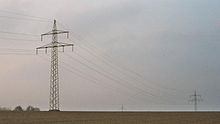- Optical ground wire
-
An optical ground wire (also known as an OPGW or, in the IEEE standard, an optical fiber composite overhead ground wire) is a type of cable that is used in the construction of electric power transmission and distribution lines. Such cable combines the functions of grounding and communications. An OPGW cable contains a tubular structure with one or more optical fibers in it, surrounded by layers of steel and aluminum wire. The OPGW cable is run between the tops of high-voltage electricity pylons. The conductive part of the cable serves to bond adjacent towers to earth ground, and shields the high-voltage conductors from lightning strikes. The optical fibers within the cable can be used for high-speed transmission of data, either for the electrical utility's own purposes of protection and control of the transmission line, for the utility's own voice and data communication, or may be leased or sold to third parties to serve as a high-speed fiber interconnection between cities.
The optical fiber itself is an insulator and protects against power transmission line and lightning induction, external noise and cross-talk. Typically OPGW cables contain single-mode optical fibers with low transmission loss, allowing long distance transmission at high speeds. The outer appearance of OPGW is similar to ACSR cable usually used for shield wires.
OPGW as a communication medium has some advantages over buried optical fiber cable. Installation cost per kilometre is lower than a buried cable. Effectively, the optical circuits are protected from accidental contact by the high voltage cables below (and by the elevation of the OPGW from ground). A communications circuit carried by an overhead OPGW cable benefits from the lower likelihood of accidental damage due to excavation work, for example road expansion or by any kind of repairing work of under ground drainage system or water supply system.
A utility may install many more fibers than it needs for its internal communications both to allow for future needs and also to lease or sell to telecommunications companies. Rental fees for these "dark fibers" (spares) can provide a valuable source of revenue for the electrical utility. However, when rights-of-way for a transmission line have been expropriated from landowners, occasionally utilities have been restricted from such leasing agreements on the basis that the original right of way was only granted for electric power transmission.
Lower-voltage distribution lines may also carry OPGW wires for bonding and communications; however, utilities may also install all-dielectric self-supporting (ADSS) cables on distribution pole lines. These cables are somewhat similar to those used for telephone and cable television distribution.
In Baden-Württemberg, Germany on several powerlines built by former EVS and which are today operated by EnBW uses such cables, which are installed like a garland on the ground conductor or an auxiliary rope of the powerline.
External links
Categories:- Optical fiber
- Fiber-optic communications
- Telecommunications equipment
Wikimedia Foundation. 2010.

